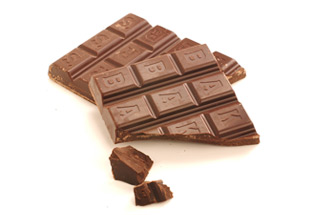

Chocolate: The Irresistible Treat
Chocolate comes from cocoa beans that are shelled, roasted and ground to make a thick, dark paste called chocolate liquor, the basic ingredient in all chocolate.
 by
Land O'Lakes Test Kitchen
by
Land O'Lakes Test Kitchen
 by
Land O'Lakes Test Kitchen
by
Land O'Lakes Test Kitchen

Chocolate comes from cocoa beans that are shelled, roasted and ground to make a thick, dark paste called chocolate liquor, the basic ingredient in all chocolate. The fat, naturally found in the beans, is called cocoa butter, which gives chocolate its smooth richness. Chocolate liquor is processed to make the many kinds of chocolate listed here.
Baking Chocolate
Chocolate used for baking is refined chocolate liquor that is not sweetened. It contains between 50% and 58% cocoa butter by United States FDA standards.
Bittersweet Chocolate
Similar to semisweet chocolate, bittersweet chocolate contains at least 35% chocolate liquor, but has a darker chocolate flavor and is less sweet. It is available in baking bars and candy bars.
Chocolate Chips/Morsels

These are small droplets that can be made of semisweet, milk, dark or white chocolate. They can be incorporated into batter or dough evenly and contain slightly less cocoa butter than chocolate bars, which helps them keep their shape when baked.
Dark Chocolate

Any unsweetened chocolate, other than milk or white chocolate, is dark chocolate. It has 65% or higher cocoa content and has been correlated with health benefits from flavonoids, which act as antioxidants.
Milk Chocolate

Milk chocolate contains 10% chocolate liquor, additional cocoa, cocoa butter, sugar, and milk or cream. It is available in chips and candy bars.
Semisweet Chocolate
Semisweet chocolate is dark chocolate that contains 15% to 35% chocolate liquor.
Sweet Baking Chocolate

Also called German sweet chocolate, sweet baking chocolate contains 15% chocolate liquor, additional cocoa and sugar. It is sweeter than semisweet chocolate. It is available in bars.
Unsweetened Chocolate
Very bitter in flavor, unsweetened chocolate contains 50% to 58% cocoa butter. It is available in baking bars.
White Chocolate

Although commonly referred to as “chocolate” because it is used like chocolate, it doesn’t contain chocolate liquor or unsweetened cocoa. It is made with cocoa butter.
How to Melt Chocolate
No matter what type of chocolate you are using, follow these simple melting methods
- In the microwave
- Microwave 1 cup (6 ounces) chocolate in a small microwave-safe bowl on high (100% power) for 30 seconds to 1 minute; stir. Microwave at additional 10 to 20 second intervals, stirring until smooth. To melt 2 cups morsels, microwave a few seconds longer.
- For one square of chocolate, microwave on high 1 to 2 minutes or until almost melted, stirring after each minute. Add 10 seconds for each additional square.
- In a saucepan
- Place chocolate in a heavy-bottom saucepan over the lowest heat. Using a wooden spoon, stir constantly until chocolate just begins to melt. Remove saucepan from heat and continue stirring until smooth.
- Using a plastic bag
- Place chocolate morsels in a heavy-duty resealable plastic food bag. Microwave on high (100% power) for 30 to 45 seconds; knead. Microwave at additional 10- to 20-second intervals, kneading until smooth. Cut a tiny corner from the bag and squeeze to drizzle.
- In a double boiler
- Heat chocolate in the top of an uncovered double boiler over hot (not boiling) water. When most of the morsels are shiny, stir until smooth. To improvise a double boiler, place morsels in a bowl set over a saucepan filled with hot (not boiling) water. Remove bowl from saucepan when morsels are melted.
What Is Tempered Chocolate?
Want to make homemade chocolate candies and chocolate-covered desserts? You should temper the chocolate. Tempered chocolate keeps its shiny appearance, smooth texture and satisfying “snap” after it cools and sets up. Tempering chocolate ensures that the cocoa butter in the chocolate melts slowly. If melted too quickly or at a temperature that’s too high, the chocolate will “bloom” (have white streaks running through it) when it sets up.

How to Temper Chocolate
- Start with chopped chocolate and melt it in a double boiler over simmering water.
- Using a candy thermometer, melt milk chocolate or white chocolate to 110° and dark chocolate to 115°.
- Allow the chocolate to sit and cool in a double boiler over warm water until it’s at the proper temperature for dipping: 87° for milk chocolate or white chocolate and 89° for dark.
- Dip nuts, pretzels, strawberries, bananas or other food into the chocolate for delicious treats that have the nice, glossy finish of a professional chocolatier.
Share Your Thoughts
Did you find this article helpful? Has it inspired you? What else would you like to know?



